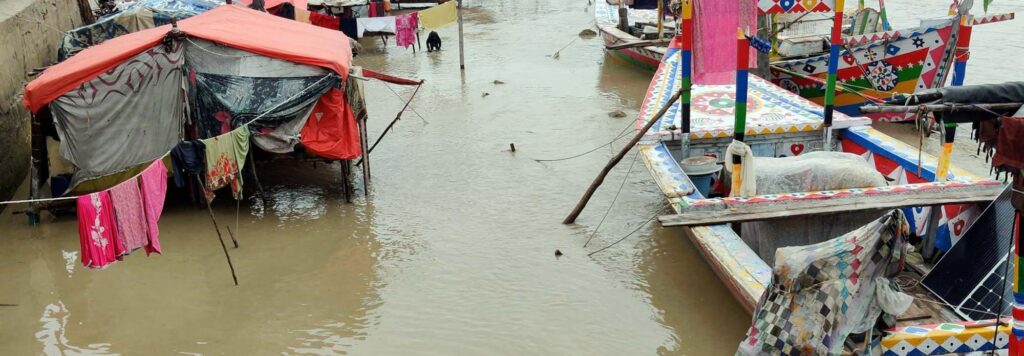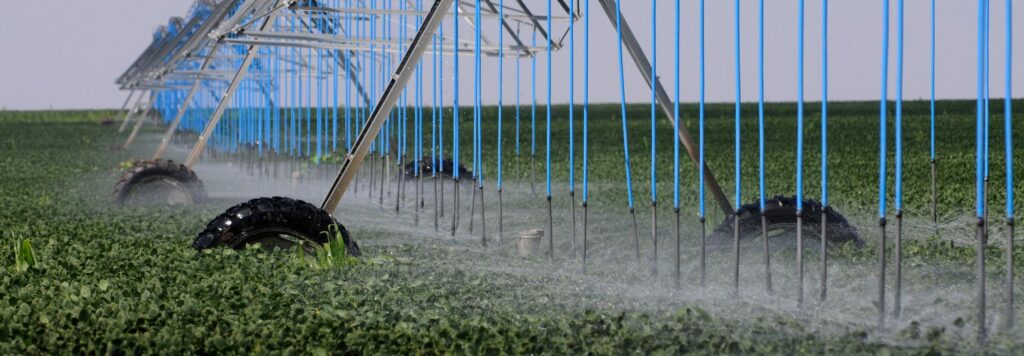n Pakistan, torrential rains and flooding in August 2022 impacted an estimated 33 million people and caused more than $40 billion in economic damages. The catastrophic flooding left 1,700 people dead, 2 million homes destroyed and killed over 900,000 livestock. Parts of the country saw five to six times the normal amount of rainfall.
The country is now experiencing mass displacement, food insecurity, loss of livelihoods and an increased risk of waterborne disease, drowning and malnutrition. Six months later, flood waters have still not fully receded, and as of early January 2023, 5 million people are still living very close to, or exposed to, floodwaters.

This catastrophic devastation has the potential of only getting worse as the floods and resulting water crisis further destabilize an already politically turbulent nation, causing national and global security problems for years to come.
Ongoing research from WRI and the Water Peace and Security Partnership (WPS) shows how water disasters become a source of instability for the people they impact.
Floods Are a Growing Threat in Pakistan
Flooding during the monsoon season (June through September) is not new to Pakistan. Similar severe events occurred in 2010, but it’s set to get worse. WRI’s Aqueduct Floods — a data tool that tracks water risks around the world — predicts that the number of people exposed to flooding will continue to increase from almost 2 million in 2010 to 5.7 million in 2030.
An early study from an international group of climate scientists found that climate change increased the likelihood of Pakistan’s heavier rainfall. High levels of poverty, poor governance and high-density development in floodplains were also found to increase the impact from a monsoon. This combination of climate hazards and existing vulnerabilities threatens security for the country, the region and beyond.

Flooding and Other Water Risks Create Instability
In addition to the immediate effects on people and their livelihoods, it is important to also shed light on indirect impacts. Devastating floods like Pakistan’s can spark humanitarian crises, with lasting impacts and compounding effects on:
- Public health: Pakistanis are experiencing inadequate sanitation and health services, disease outbreaks and lack of access to clean water, toilets, medicine, sufficient food and more. Diseases are spreading, including cholera, malaria, dengue, scabies, lumpy skin disease, hand-foot-and-mouth disease, mosquito-borne illnesses and zoonotic diseases affecting livestock. Children, especially those in camps for displaced people, are highly vulnerable to acute respiratory infections, diarrhea, malaria, malnutrition, skin diseases and typhoid. In mid-October, about two months after the flooding, the UN recorded a peak of about 100,000 cases of malaria in the country.
- Water security: Flooding pollutes drinking water, limits the supply of water, destroys water management infrastructure and can bring waterborne diseases. Water insecurity can also be linked to violent conflict, according to the WPS. The WPS Early Warning Tool predicts continued and emerging conflict in parts of Pakistan this year.
- Food security: Agriculture is especially vulnerable to natural disasters like floods, which cause major harvest and livestock losses, according to the International Atomic Energy Agency. At least 4 million acres of crops have been destroyed. With the planting season started, and a significant amount of agricultural lands still flooded, farmers were unable to plant new crops. Experts foresee a secondary hunger crisis if harvests fall short next year. Already, anemic mothers are delivering babies at very low birth weights. The impact on food security is not only limited to Pakistan. Pakistan is one of the world’s largest exporters of wheat and rice, which is expected to be impacted by the floods. This also threatens Pakistan’s agreement to sell these crops to the World Food Programme, to reduce food shortages in Afghanistan. This is happening during a time of inflation and high food prices in part due to the Russian invasion of Ukraine and supply chain interruptions from the COVID pandemic which raises the threat of food insecurity. The UN recently reported that an additional 1.1 million Pakistani people will face emergency food security conditions in early 2023.
- Energy access: Only one-quarter of Pakistanis have access to electricity, and the demand to increase energy output is growing. Over the next seven years, Pakistan plans to double hydroelectric output to combat its electricity deficit. But energy dependence on hydropower raises risks of transboundary water issues — or increased tensions between state actors over water issues — with India, a country that is already suffering from water-based energy insecurity.
- Housing: The summer floods washed away entire villages, putting 10 million children in need of lifesaving support and forcing over 3.4 million children to leave their homes. With millions of homes destroyed, Pakistan is experiencing mass displacement, the need for displaced persons camps and internal movement could cause increased competition in hosting communities.
- Failing and damaged infrastructure: The flooding and ensuing landslides have destroyed critical infrastructure such as bridges, homes, hospitals, public health facilities, roads and schools. This destruction of rural infrastructure and irrigation systems threatens public health and national security.
Instability Threatens National Security
This flooding disaster and humanitarian crisis hit Pakistan at a time of ongoing political turbulence. Last year, Prime Minister Imran Khan was ousted by constitutional means with a vote of no confidence, but his opposition to the legitimacy of the new government creates uncertainty about the political future of the country and fears of violence. In early November, Khan survived a gun attack during a protest march.
Meanwhile, allegations of government corruption and support for extremist groups are challenging relationships between Pakistan and western countries and multinational organizations have imposed conditions on Pakistan that could cause internal and international strife, such as the International Monetary Fund’s aid terms stipulating that Pakistan reduce debt payments to Chinese power producers.
Pakistan is in desperate need of international aid and adaptation support, to build climate resilience and prepare for future disasters. A lack of government assistance during natural disasters like this one may delegitimize the current administration, already on shaky footing. There have already been protests blaming the government for insufficient flood relief.
Increasing instability could create a power vacuum, leaving Pakistan, a nuclear country, vulnerable to external influences (or the perception of external influences, reinforcing possible army intervention in the government), extremist organizations and others. The Taliban’s sudden takeover of Afghanistan in August 2021 and their long-lasting relations with Pakistan and Pakistani government’s inability or unwillingness to influence the group’s activities in Afghanistan have increased frustration in western countries. Increased attacks in Pakistan by the Tehreek-e-Taliban Pakistan, which is inspired by the Taliban’s victory in Afghanistan, have raised concerns and criticism even in inner circles within the Pakistani establishment.
Decreasing Water Stress Can Boost Pakistan’s Stability
Pakistan is one of the most water-stressed countries in the world. Only 36% of Pakistanis have access to safely managed drinking water, down from 38% in 2004. The summer floods have severely limited access to clean drinking water and water, sanitation and hygiene facilities, while raising the risk of waterborne illnesses.
This insecurity will worsen without stronger, sustainable water management. The WPS finds that violent conflicts rise from water crises. Violent protest broke out in Iraq in 2018 after low flows in the Tigris and Euphrates rivers allowed saltwater to flow upstream, ruining freshwater sources. In 2019, violence escalated in Mali and several hundred people were killed in conflicts over water access between herders, farmers and fishers in the Mopti region. Chennai, India has also experienced violent conflicts over water resources following years of drought.
But solutions exist, and Pakistan can implement them to decrease its water stress:
- Improve water governance: Countries should adopt integrated water resource management that considers all competing interests’ needs for water resources and adopts better data to inform allocation of resources.
- Increase agricultural water use efficiency: Farmers should switch to more water-efficient crops or better target water in irrigation, rather than use methods like flooding fields.
- Invest in nature-based solutions: Green infrastructure like wetlands and forests improve water quality and spread supply out over longer periods, building resilience against both droughts and floods.
- Treat and reuse wastewater: With wastewater treatment, wastewater isn’t waste but can become a new water source.
- Invest in flood protection infrastructure: Maintaining flood protection infrastructure can help prevent casualties and create local jobs. Flood protection measures also offer a strong return on investment. For example, Aqueduct Floods finds that if Pakistan moves from its existing 9-year flood protection system to a 25-year flood protection system by 2050, every $1 spent on dike infrastructure in the country may result in $11.90 in avoided damages to urban property. This investment would reduce the likelihood of floods from 11% to 4%.
WRI’s and WPS’ 2020 report, Ending Conflicts Over Water Solutions to Water and Security Challenges, also identifies strategies to reduce water-related security risks. It is intended for global development, diplomacy, defense and disaster response experts, as well as for national- and river basin-level decision-makers charged with addressing natural resource-based conflict, migration and other forms of insecurity. Policymakers can tailor solutions to their unique water challenges that are organized into four broad categories:
- Natural resources, science and engineering approaches
- Political and legal tools
- Economic and financial tools
- Policy and government strategies.
Preparing for Future Floods
The Pakistani government should work to build back better and invest in adaptation, resilience and long-term infrastructure. Adaptation and resilience initiatives include rebuilding outside of flood zones and strengthening early warning systems and planning.
Climate change is increasing the frequency and power of monsoons and other natural disasters. Countries like Pakistan — already facing devastating impacts — should work to alleviate poverty; implement adaptation strategies and nature-based solutions; and improve water resources management, flood prevention, drought response, food security and access to safe, reliable and affordable water for all. By doing so, countries “could be on a path to preventing some of the worst health outcomes of disasters,” according to Kristen Patterson, director of Drawdown Lift at Project Drawdown, in an article in the Scientific American.
But without political reform, Pakistan will continue to suffer the increased magnitude of natural disasters and other impacts of climate change.
However, one of the most important reforms lies beyond Pakistan. Industrial nations must severely cut greenhouse gas emissions to protect Pakistan and other vulnerable nations and communities from the catastrophic effects of climate change. That includes Pakistan’s most important partners and allies, China, the United States and Russia and Pakistan should consider using whatever leverage it has with these countries to push for reductions in emissions.










